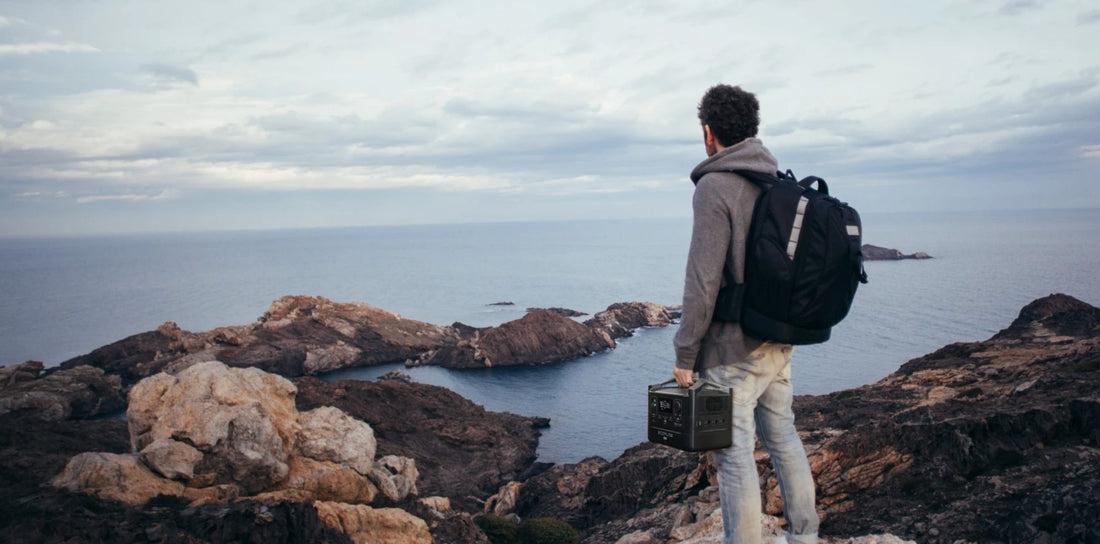
What’s a Portable Power Station?
Eco PoweritShare
In short, it's a unit that powers other electronics using a rechargeable battery. They can be big enough for home backup or small enough to take camping. They generally have some combination of AC (wall) outlets, USB outlets, and sometimes less common types of outlets. What makes them different from other energy storage devices is that they balance high capacity with portability.

How Does A Portable Power Station Work?
Portable power stations convert and store energy from several sources: A traditional household wall outlet, a car adaptor, or adding EcoFlow Solar Panels to harness clean, renewable energy from the sun. The portable power station stores electricity until you need it, and each model offers a variety of outlets: from USB-A and USB-C to traditional AC plugs.
Our patented X-Stream technology offers the fastest recharge times of any portable power station on the market — 0 - 80% capacity in just one hour or less. With the addition of Ecoflow Solar Panels, our portable power stations can recharge fully using solar power in 3-6 hours.
Is a portable power station just a big battery?
Is a bank just a vault? Though the battery is the main part of a portable power station, there are also a number of components and technologies that send stored energy safely and efficiently to your appliances. They have tech that makes them recharge faster, screens that show input and output, and even apps for remote energy management.
What’s the difference between a solar generator and a portable power station?
Just the names – neither a portable power station nor a solar generator create energy, they just store it so you can use it anytime. The same goes for battery-powered generators. The “solar” element just indicates that generators can connect to solar panels, but so can portable power stations with an XT60 port.
How is a portable power station different from a power bank?
Portable power stations have much more capacity and outlets than power banks, which usually only have USB outlets. Portable power stations can be used for things that would normally plug into a wall or car outlet. This is because they have enough juice to power big things for a while and can send out more electricity.
What should I look for when choosing a portable power station?
The trend seems to be around $1 per watt-hour of capacity. But like anything, specs, features, and lifespan affect this number. As with most tech, it’s best to get a bit more than you plan to use today so you don’t limit yourself tomorrow. We’ve come up with some good points to compare.
Capacity
How much electricity a portable power station can store is measured in watt-hours (Wh), which is one watt of electricity being used for (you guessed it!) one hour. That means a 500Wh portable power station would power a 50W bulb for 10 hours (if it were 100% efficient).
So, let’s say you’re throwing an outdoor summer party for 3 hours and plan to bring:
• Iceless cooler (50 watts)
• Set of lights (25 watts)
• Slow cooker (75 watts)
All of the devices above add up to 150 watts, and if you need to power them for 3 hours, you would need 450Wh of capacity (technically speaking, you’ll need slightly more than that – there’s conversion loss and it’s best not to drain the battery to 0%).
So now that you know about capacity, let’s take a look at portability.

Portability
Battery chemistries have moved away from the lead-acid ones found in cars, and as a result, are now much lighter and more efficient. We’re still not at the point where your house can run off of a battery the size of your phone, but we’re getting a lot closer. There are plenty of things you can use with today’s portable power stations that you couldn’t have done feasibly a few years ago.
The tradeoff between weight and capacity has reached the point where you can pick up a battery that can power a TV for 24 hours. Smaller sizes you can take on a hiking trip may be able to power small appliances for a few hours. If lifting it up isn’t necessary, bigger ones usually have wheels and can power large appliances and power tools for several hours.
Lifespan
Seeing a battery as an investment is sort of a new concept. With portable power stations, you’ll want to factor in how much use you’ll get out of it, which varies by product. Lifespan is measured in cycle lifes, where one cycle counts as using a completely full battery until it’s completely empty. Using it to only 50% counts as half of a cycle.
500 cycles might not seem like a lot, but that’s only until it has 80% health. Phone batteries tend to be rated for 300 to 500 cycles and are constantly being drained and recharged, so they go through cycles pretty quickly. Even after using a portable power station to a 50% battery level every day for 3 years, you’d still have 80% of the original capacity.
Features
At the very minimum, portable power stations should have USB and AC outlets. From there, the bells and whistles to keep in mind are solar panel compatibility, app functionality, expandable capacity (i.e., adding batteries), and having a variety of input and output ports.
Should I just get a gas generator?
Gas generators do move a lot of power, we’ll give them that, but… they can’t be used inside, they’re super loud, and you can’t recharge them for free. There’s also the issue with being harder to start and being pretty unsophisticated. People like portable power stations because it feels more natural to just press an “on” button and not have to winterize or check fuel levels. Gas generators were the go-to for a long time because that’s all there was, but now there are portable power stations big enough for energy demanding equipment like air compressors, table saws, and conventional ovens.
Our portable power stations
EcoFlow’s portable power stations have been highlighted by top reviewers for their recharging times, high output, and iconic design. For electricity going in, we can proudly claim the world’s fastest recharge time. For electricity going out, outlets of all shapes and sizes let you bring along pretty much anything.
RIVER – Best for outings
Got a beach trip coming up? Me neither, but there are plenty of places you can take RIVER. It’s got way more capacity than a power bank, and AC ports to power laptops, lights, and small appliances. It’s where ideas for creative get-togethers begin.
RIVER Pro – Best for outdoors
Packing a bit more capacity, it can turn a plain jane camping trip into an outdoor experience. With extra capacity, it goes beyond recharging devices; chill some drinks, cook a pizza, throw on the projector, make it fun.
DELTA – Best for outages
Though it can handle big appliances when the power goes out, why miss out on all the fun in more favorable weather? Its high output is perfect for worksites where there aren't any plugs or for bringing some life to an outdoor venue. If you're into RVing or boating, it's a handy option to have aboard.

RIVER
Capacity: 288Wh
Cycle life: 500+Solar
Input: 200W
AC outlets: 3
The EcoFlow RIVER gives you grab-and-go power to keep all of your appliances charged up.
$349
Buy Now
RIVER Pro
Capacity: 720Wh
Cycle life: 800+Solar
Input: 200W
AC outlets: 3
Step into the wild and go totally off-grid with the EcoFlow RIVER Pro. It keeps your appliances powered for hours and hours.
$649
Buy Now
DELTA
Capacity: 1260Wh
Cycle life: 800+Solar
Input: 400W
AC outlets: 6
$1,399
Buy Now
Whether you’re looking for backup power at home, on the go, or for DIY projects, the EcoFlow DELTA has a massive capacity that’s got
